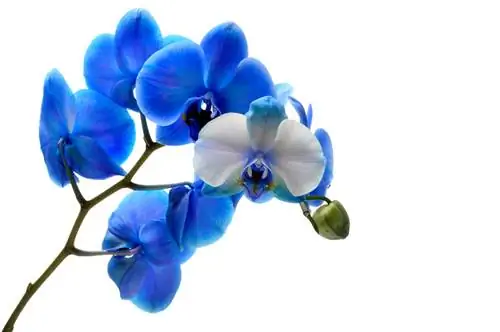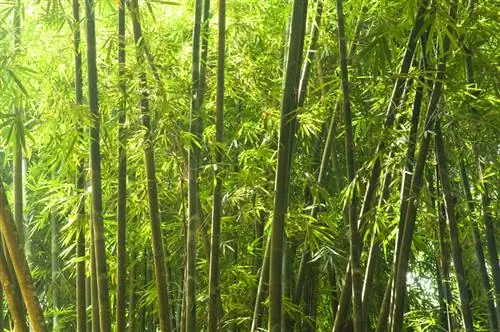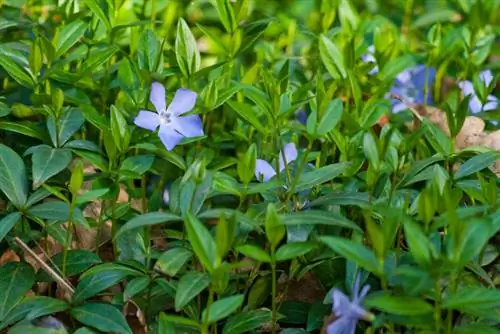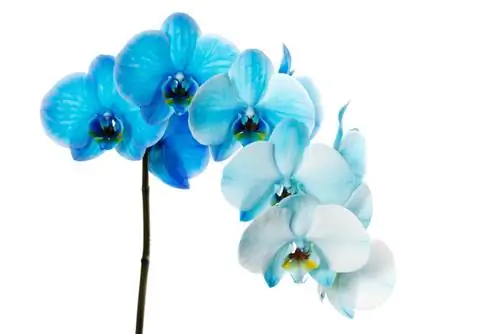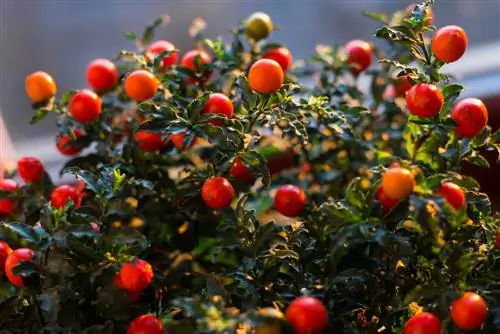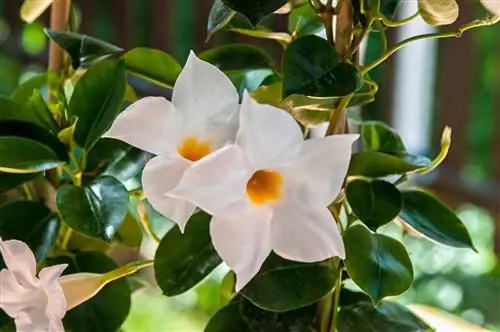- Author admin [email protected].
- Public 2023-12-16 16:46.
- Last modified 2025-01-23 11:20.
Their bright blue flowers magically attract us in the garden center and supermarket. The blue orchid is surrounded by a mysterious magic because it is extremely rare in the wild. You don't have to be an orchid expert to suspect that Mother Nature was messing around here. We explain how the blue color gets into the flowers. There are also tips for coloring yourself.
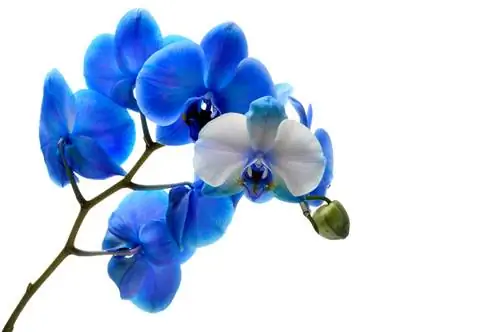
How do blue orchids come about?
Blue orchids are created by dyeing a white Phalaenopsis orchid using an infusion of a secret blue dye. To get the blue color, add blue food coloring to the plant's dipping water without wetting the heart of the plant.
Dutch breeder with the patent for blue dyeing - This is how it works
We owe the blue flowers that we usually look for in vain in tropical climes to the stroke of genius of an orchid breeder from the Netherlands. The inventor patented the dyeing technique, so that the procedure was not made public down to the last detail. At least you can see how it works with the following overview:
- A pure white Phalaenopsis orchid acts as the starting material
- At the time of sprouting, the flower stalk is connected to a drip via an infusion needle
- The drip is filled with a secret, blue liquid
- The infusion needle is inserted into the stem near the base
As the buds develop, the butterfly orchid remains connected to the drip. In this way, it continuously absorbs the blue liquid, which is distributed throughout the entire plant via the ducts. This process can be recognized by the fact that the aerial roots also turn blue. If everything goes according to plan, blue flowers will unfold.
Care requires a special extension
The Phalaenopsis was chosen to act as a starting plant for blue orchid flowers, not least because of its undemanding frugality. To ensure that the unique tint is retained over a long period of time, the normal care program is expanded to include an important aspect. This is how it works:
- During the flowering period, dip a blue phalaenopsis in lime-free, warm water in dry conditions
- Add blue food coloring to the dipping water
Please do not let the water penetrate into the heart of the plant or into the leaf axils, as this can cause rot. If no more air bubbles appear, allow the blue immersion water to drain well before placing the orchid back in its planter.
Blue flowers with short half-life
Without expanding the care program to include blue food coloring in the watering water, the blue color will visibly decrease in radiance as the flowering period progresses. Halfway through the time the color changes to light blue. When the flowers are shed, the blue magic is finally over. The next generation of buds blooms in pure white.
Dye your own blue orchid - tips for the chameleon orchid
It's no surprise that you have to pay a significantly higher price for a blue orchid in stores. The inventor-breeder invested a lot of money and even more time in the development of his patent. He also emphasizes that the dye is a highly developed chemical preparation that is not available for purchase. The tinkerers among the orchid lovers tried it anyway. This is how the plan can succeed:
- A white-flowering Phalaenopsis orchid is well suited
- Attach a 10 ml syringe of blue food coloring to a freshly emerging flower stem
- Carefully push the needle at a slight angle to the middle of the stem
- Attach the infusion needle to the shoot with adhesive tape or other binding material
- Fill the syringe regularly until the blue buds open
If you only apply the infusion when the orchid is already in full bloom, you will be disappointed with the result. In field tests, the white flowers only turned a pale, light blue color. If, on the other hand, the Phalaenopsis is exposed to blue food coloring while it is sprouting, there are better prospects of a rich blue tint.
Alum unsuitable for coloring
What is so easy to color hydrangeas blue in the garden ends in a fiasco when it comes to orchids. In order to color the popular flowering trees in the bed blue, the pink-flowering hydrangea varieties are given a special fertilizer based on potassium aluminum sulfate - alum for short. This trick is futile on orchids, as the aerial roots expire within a short time due to the high s alt content of alum.
Coloring orchid panicles blue in the vase - this is how it works
If coloring orchids via infusion is too delicate and complicated for you, you don't have to do without the blue flowers. While ink is unsuitable as a dye for the plant, ink water can be used safely in the vase. To do this, cut off a white-flowering Phalaenopsis panicle and place it in an opaque vase with a mix of lime-free water and ink.
Tip
In contrast to the blue Phalaenopsis, a Vanda coerulea produces enchanting blue flowers without the use of chemicals. Above all, the magnificent variety 'Vanda Royal blue' repeats the royal flower show every season when properly cared for. The most important premises are a bright location with 25 to 28 degrees Celsius and high humidity of 60 to 80 percent.

